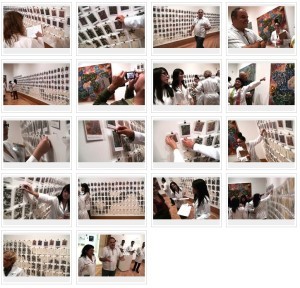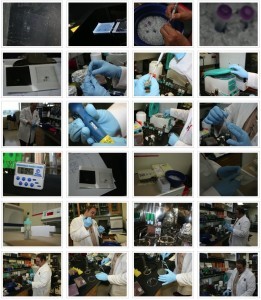Sequentia
Xavier Cortada’s solo exhibit at the Frost Art Museum explores the sequence of events that make up life on the planet from the molecular to the monumental.
The title of the exhibit also references a series of actions Cortada will set in motion to create of a unique strand of DNA. The artist will work with a molecular biologist to synthesize an actual DNA strand made from a sequence generated by museum visitors using Cortada’s art.
In The Four Nucleotides, the artist creates large scale “portraits” of Adenine, Cytosine, Guanine and Thymine— the four bases of a DNA strand that summarize all we are, were and will be.
 Participatory Installation
Participatory Installation
In Genetic Sequence, the artist invites museum visitors to randomly select a postcard depicting one of Cortada’s four Nucleotide paintings and place them sequentially within small plastic bags hanging in a grid on a wall.
In placing the nucleotide postcards, the visitors will assist in the development of a DNA strand as part of a participatory installation.
 LabARTory Sessions
LabARTory Sessions
Two weeks into the exhibit, the artist will engage in a series of LabARTory Sessions with Dr. Kalai Mathee, FIU Department of Molecular Microbiology and Infectious Diseases Founding Chair.
In her lab, Cortada will determine if the random sequence being generated by the participatory art project exists anywhere in the human genome.
During these performative sessions, Cortada will use the sequence to create a live DNA strand, insert (clone) it into a vector (plasmid) and propagate it in a bacteria on a Petri dish.
 The presence of the specific DNA strand will also be analyzed using agarose gel electrophoresis, sequenced and analyzed against other existing DNA sequences.
The presence of the specific DNA strand will also be analyzed using agarose gel electrophoresis, sequenced and analyzed against other existing DNA sequences.
As they become available, the results will be exhibited in the museum alongside the petri dish and a microfuge tube filled with the amplified DNA molecule.
Results
TCTAATACAATCCCTACGTGACTGTGTATAAATGTGAAAGCTA
TATTAATGTCGCAGCTAGTCTCATAAAAGATTCCTACAACGCG
ACGGATCTATACCTATGCCATAGTCCCAGCTTTTACTTATTCTC
ACAATTTTACATTTTTGGGCCAACAGGACCGTCCTCATGCTTA
CCATATTCCTTCAGCTTAATATAGCTGATCTCTACACTCAAACC
ACCTCGTGTGCTGGTCTCGAGAGTTGCCCTTACCCGAGGCTT
GGTGTACTGGGTGTAAGTAAAAGTTGGATAGGCCCGTCCTTG
GAGACGTCGAACTAATTTTGAGAGCGCATCTGCTTCCATACTT
GTATCCCTGTTGTCCTTCGGCACACGTGGAACTGACTTGCCTC
AAAAAGGGTAACA
above: screen grabs courtesy of wetheat.tv
Was the random sequence (above) generated by the participatory art project similar to a DNA sequence found anywhere in the human genome?
Yes! A portion of the sequence was similar to the portion of human Chromosome 3 which encodes for proteins that direct the navigation of axons in human neurons!
On November 10th, 2010, using the participants’ sequence, Cortada synthesized the 400-nucleotide DNA molecule and named it “Sequentia.”